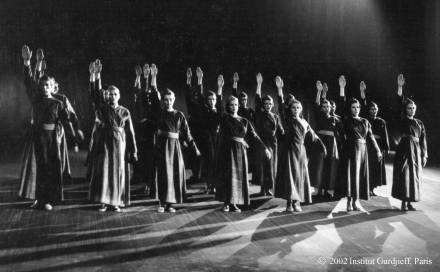
“Dances are for the mind. They give nothing to the soul—the soul does not need anything. A dance has a certain meaning; every†movement has a certain content.” G.†I. Gurdjieff 1

“One moves the movement and forgets the movement, this is not the movement in itself. If, when stimulated by external things, one moves, it is the impulse of the being. If when not stimulated by external things, one moves, it is the movement of heaven.” 2This ancient Taoist saying could very well be an introduction to the understanding of the “Movements” which hold a very special place in the teaching of G.†I. Gurdjieff. The formal performance of the movements, their external action, is the echo of an inner and more potent current of energy. Through the cyclic repetition of a series of attitudes—like the reiteration of a prayer—the attention is sharpened, setting free energies of different qualities and densities (what the Hindu tradition calls pranas) and allowing them to be related to one another in a new way. The outer motion is initiated through the impulse issued within, no longer from a one-sided attention, but from an embracing vigilance supported by the body, in accord with the feeling, and under the look of the mind: a threefold attention.
The Movements are spiritual exercises, neither gymnastics nor physiotherapy, and are not meant to create altered states of consciousness (even though this might happen as the automatic result of a work of attention). Their raison d’Ítre has to be found in the body of ideas structuring the teaching. The Movements have been created for the experimentation and practice of data which, for the most part, are conveyed orally. When deprived of this connection with the ideas, counterfeit and distortion ensue, and the Movements lose much of their meaning.
“When the movement is right,” said Mme. de†Salzmann, “it produces a sound … a special influence which may be received by those who listen.” It is like the reverberation of vibrations coming from a higher level of consciousness, which might be felt not only among the people performing a given movement, but also by those watching them. In that respect one can say that the Movements are an illustration of the practice of the three lines of work characteristic of the teaching: work on oneself, work with others, and work for the community.
When one begins to study the Movements, very quickly what becomes obvious is the weakness of the attention: it has no endurance, no defense against the endless motion of the associations, and it is often unconsciously taken away at the very moment that its full concentration would be needed. The ordinary mind, by itself, is unstable, being oriented either towards the future or looking back into the past, and, being most of the time identified with some imaginary object, it has no center of gravity. This attention of the mind can initiate a movement or show a direction, but it is unable to engage itself and to participate in the continuity of this movement: “One moves the movement and forgets the movement, this is not the movement in itself.”
As for the body, even though it can sometimes show a real intelligence when confronted with the outside world, it is mostly under the sway of its desires, appetites and reactions. However, on the path of inner search, the acknowledgement of the body as an essential foundation for the Work is primordial. At the very beginning of the practice of the preliminary exercises the effort of the attention to memorize different postures seems to be solely formal and to depend mainly upon physical aptitude. But as the exercises become progressively more and more complex, the difficulty of facing the growing demand for coordination of different speeds, different tempos, and different rhythms associated with complicated displacements and canons, calls for a new attentiveness never experienced before.
At that very moment, out of the vision of my being taken aback, absent, the question arises: “Who am I?” There will be, of course, no immediate answer. But the seeing and the acceptance of this lack of relation within myself evoke a nostalgia, the remote memory of a lost authority, a remembering. I am compelled to try to attend as a three-brained being, in other words, I am compelled to try to be present.
What is taking place then, is the awakening of a finer intelligence, a new mind, a thought coming as it were from the heart, the discovery of what in Beelzebub’s Tales to his Grandson Gurdjieff calls “Being Mentation.” The search for this inner presence requires a sacrifice, the letting go of all subjective temptations and all egoistic fascinations: to succeed, to “do,” to get results. This opening to a higher level of consciousness is what we are invited to discover in the practice of the Movements as “Sacred Dances.”
1 Views from the Real World: Early Talks of Gurdjieff. Arkana, 1984, p.†181.
2 The Secret of the Golden Flower: a Chinese Book of Life. Translated by Richard Wilhelm, Harcourt, Brace & World, 1931, 1962, p.†58.
| Copyright © 2002 Paul Reynard This webpage © 2002 Gurdjieff Electronic Publishing Featured: Spring 2002 Issue, Vol. V (1) Revision: April 1, 2002 |
Paul Reynard joined a small group in Paris led by Henriette Lannes in 1946. He began to practice the movements in 1947 with Jeanne de Salzmann, and joined the senior class under the direction of Mr. Gurdjieff that fall. He began as a movements instructor under Marthe de Gaigneron, and in 1969 came to the United States. Since then, he has borne responsibility for movements in the Gurdjieff Foundation of New York and other US as well as Canadian Gurdjieff Foundations.